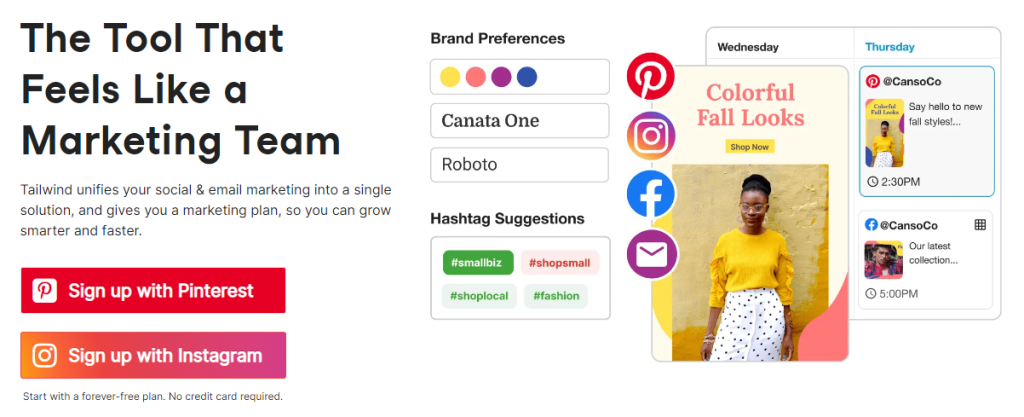Social media has become a necessary part of any marketing strategy. With the amount of time it takes to manage accounts on all the major networks, there is no way you can make your social media as effective as it needs to be. This blog post will give you 25 tips for managing your social networking accounts and getting better results in less time!
What is Social Media Management?
Social media management refers to the process of planning, implementing, and monitoring social media campaigns and activities across multiple platforms. It involves creating and sharing content, engaging with an audience, and identifying areas for improvement.
Social media management can be a time-consuming process, as it requires regular attention and updates to keep social media profiles active and engaging. As a result, many small businesses choose to use social media management tools or services to help them manage their social media channels more efficiently. These tools and services can provide a range of features, including the ability to schedule posts in advance, track and analyze social media metrics, and engage with followers.
Overall, the goal of social media management is to effectively use the right platforms to build and maintain a strong online presence, engage with customers and followers, and drive business growth.
Why Does a Business Need Social Media Management?
There are several reasons why a small business might seek out a social media management service:
- To build and maintain a strong online presence: Social media management can help you establish and maintain a strong online presence across multiple social media platforms. By regularly posting content and engaging with followers, you can build their brand and reputation while attracting new customers.
- To improve customer engagement: Social media management can help you improve your customer engagement by providing a platform for customers to ask questions, give feedback, and share their experiences. By actively listening to and responding to customers on social media, you can improve customer service and build stronger relationships.
- To improve traffic and sales: Social media management can help you drive traffic to your website and increase sales by promoting your products or services on social media platforms. By using targeted social media advertising and engaging with followers, you can reach a wider audience and increase your online visibility.
- To monitor and analyze performance: Social media management tools often provide a range of analytics and reporting features that can help you understand how your social media efforts are performing. By analyzing metrics such as engagement, reach, and conversions, you can identify areas for improvement and optimize your social media strategy.
Overall, social media management can be an effective way to build and maintain a strong online presence, improve customer engagement, drive traffic and sales, and monitor and analyze their performance on social media platforms.
Best Practices for Social Media Management
Set specific parameters: This includes the type of content created, when it should be posted, and how often a particular platform is updated with new posts. It’s best to remain consistent as possible with these parameters, so that people don’t feel bombarded by too many messages.
Use the tools: Take advantage of the many tools available, like Hootsuite, which come with loads of cool features that make your job easier! You’ll still need some human input to monitor activity happening within the different platforms, but automating certain tasks will help free up some time.
Use all platforms: To get the most from social media, you should explore how each one can help your business. This can include Facebook, Twitter, Instagram, YouTube – the list goes on! The more diverse your posts and platforms are, the better chance you have at being seen by different types of customers too.
What Are The Benefits of Social Media Management?
Social media management is the key to a successful marketing campaign. Specifically, it provides the following benefits:
Free to access: Social media is an amazing tool for reaching your audience and building a following. It’s free to join social media networks, post content, and respond to user comments. All of this can be done in the comfort of your own home or on the go with just about any device you have!
International reach: The best way to get your message out there is through social media. Traditional marketing and advertising can’t even come close in terms of reach or price point. With the right strategy, you’ll be able to harness a global audience for pennies on the dollar. You just need someone who knows how to use it wisely!
Get involved: Believe it or not, social media hasn’t been around for that long. With just one decade behind us and an internet-driven society at our fingertips, many businesses are still catching up to the power of social media in today’s marketing strategy.
Social channels now account for 74% of people making purchase decisions. This is a huge number when we consider how heavily we rely on reviews from friends and family before purchasing anything these days. Not only this, but 80% get their advice about what they should buy through social networks like Facebook and Twitter too!
Results: There is a lot of potential for advertising and marketing through social media. Social networking sites are excellent platforms to promote brands, generate leads, and sell products because they allow businesses to engage with their customers on an individual level in real time.
If you have an ecommerce store and want to utilize social media more effectively to sell more of your product, then we have the perfect blog article for you! Check out our list of 7 Key Social Media Tips For Ecommerce.
What Platforms Does Social Media Management Cover?
Social Media Management includes all major social media platforms, including Facebook, Twitter, LinkedIn, Instagram, and YouTube. Let’s get a little overview of each:
Facebook: Facebook is the most popular social media platform, boasting over a billion monthly active users (MAUs). With more than 50% of all adults on Facebook in some form or another, it’s hard to go wrong here. With so much data at your disposal, Facebook ads are one of the top marketing strategies for getting your product in front of potential customers.
LinkedIn: LinkedIn provides an excellent way to connect with professionals from around the world – including potential clients! The company currently boasts over 500 million MAUs worldwide, and that number continues to grow each day as new people join up looking for jobs, networking opportunities, and job leads.
Twitter: Twitter may be one of the lesser- known social media platforms, but marketers should not overlook it! With over 300 million MAUs worldwide and the ability to engage in a number of viral topics, this site’s audience is still significant.
Instagram: With over 2.35 billion monthly active users, Instagram is one of the most popular social media sites on earth. This is the social media to use if you sell a product or service that can be photograph and shown to potential customers.
YouTube: YouTube is the world’s second-most popular site, with over a billion MAUs. It provides marketers and businesses alike with an excellent platform for creating video content that can be accessed by people around the world. This site also has its own inbuilt advertising service that can help you reach your target audience.
Best Social Media Management Tools
Social media management tools are a great way to make the experience of using social networks more productive and exciting. These paid and unpaid options will help you schedule posts, respond to comments, create content calendars for your followers – just about everything!
Hootsuite: Hootsuite is one of the most popular and widely used social media management tools around. It allows users to manage multiple networks at once, schedule posts ahead of time, analyze campaigns for success – all with an intuitive interface that makes it simple to use.

Tailwind: Tailwind is an affordable and easy-to-use social media management tool that can be used for free. It includes analytics, content creation, scheduling posts – all with a robust set of tools that makes it a great option for marketers on any budget!

Buffer: Buffer is another popular social media management tool that is free for up to three social networks. It allows users to schedule posts ahead of time, as well as analyze the success or failure of any campaign – and it’s super easy to use!

CoSchedule: CoSchedule offers a paid subscription option with an intuitive interface perfect for small businesses. The paid version includes features like integration with Google Analytics, SEO insights, and an extensive library of social media content to use in your marketing campaigns.

Key Tips to Managing Social Media Accounts
1.) Create a social media presence
It’s important that you create profiles on all social media platforms where it might be relevant for finding potential new customers. Some examples include Twitter, Facebook, Instagram, etc… However this isn’t as straightforward as simply logging into these sites and waiting for people to arrive – there’s more involved than just that!
2.) Find your ideal audience
When you’re starting out, the first thing to do is find your target audience. This will help shape your marketing approach and allow you to cater towards their needs. If possible, try talking with current customers in order to get a better understanding of who they are and what they like about your brand or products.
Related: When is the best time to post on TikTok?
3.) Post regular updates
One of the most important things for any social media account- whether it be personal or business-oriented – is regular updates! It might seem like an overwhelming task at first but remember: “easy does it” and soon enough this will become second nature. With a little time (and effort) in front of the computer screen each day, before you know it those followers will start rolling in!
4.) Build a strategy
Once you’ve identified where your customers spend their time online (i.e., Facebook vs Twitter), make sure that every social media post and update is consistent with your brand’s core values. For example, if you’re a retailer that specializes in kids’ clothing, make sure to include lots of photos or videos of children modelling the clothes on social networks where parents are most likely to see them.
5.) Respond to customer questions
Social media has some great benefits for customer service teams who would otherwise have trouble keeping up during peak times. It also allows you to communicate with your customers from any location – whether you’re on the train, going for a walk, or waiting at the dentist. We recommend investing in a social media tool like Sprout Social, which allows customer service teams to monitor conversations across all major channels and respond quickly.
6.) Focus on quality content
One of the main problems with social media is that people are always trying to keep up. They don’t spend enough time on any one platform and it ends up hurting their results. Make sure you’re using hashtags, tagging influencers, uploading images and videos at least once a day – but no more than twice or three times per day for each network!
7.) Be a real person
Social media is just like real life. If you want people to respect and trust your brand, talk about things that are important in their lives too! It’s really simple: if they mention something interesting or exciting happening in their life, send them a congratulations tweet!
8.) Be charming / unique
Not only should you be keeping up with your content, but you need to keep up with the comments and posts in general. If people are asking questions or making positive remarks about a post of yours from weeks ago – make sure that those responses get seen!
9.) Automate repetitive tasks
This is a website that allows you to create “recipes” for social media tasks. For example, if a user tags your business in an Instagram post, IFTTT can automatically like the photo and follow them! There are hundreds of recipes available on their website that will save you time while still allowing you to be present online!
10.) Invest in a scheduling tool
If this is all starting to sound like too much work, then it’s time to invest some money into the process! There are so many great tools out there, like Hootsuite and Buffer, which make social media less daunting and do most of the work for you. Allocate more time towards planning creative posts instead!
The only thing is that many social media experts will tell you not to rely too heavily on these because they remove some of the personalization involved in building relationships online. You still have to comment back personally every once in a while.
11.) Tackle posts in batches
A great way to use your time wisely without spending too much energy on one post is to batch them together. For example, if you have ten posts about a certain product launch going live at noon tomorrow (or even later today), then upload all ten posts right before 11:00 pm tonight so they go out automatically throughout the morning tomorrow when most followers will be online.
12.) Hire help if needed
In this day in age, with so much information available online it can be difficult to keep up with your own accounts. This is why many businesses hire people just for their social media management needs! Not only will you get better results from these professionals who know what they’re doing and how each network works, but you’ll also have more time during your busy workdays.
13.) Reuse content
No matter how unique your posts are, there is always a good chance that at least some of it will be similar to another post you’ve written in the past (or even something from your competitors!).
A great way to save time when writing new posts about existing topics is to use what you have already created and change certain words or phrases within them without changing the context too much. That way, you’re not spending more energy than necessary on every individual piece of information!
14.) Save posts for later
Sometimes you might have great ideas that are not quite ready to be posted. Rather than spending time on a post that isn’t perfect (or even good enough), save it in your drafts or add it to an evergreen content calendar and pull from it another day when you need something new. This way, the quality of your social media stays high without needing as much extra effort!
15.) Over-deliver with images & videos
Perhaps one of the best ways to get traffic back to your site is by posting interesting pictures and videos related to topics covered within each network. These can include both multimedia assets created specifically for this purpose, along with user-generated photos/videos shared by fans who think their work would benefit others looking at your posts.
16.) Be consistent with your language
The most important tip you can keep in mind to make your social media management effective is consistency, both from an account-performance standpoint and a content creation one. Make sure that no matter what happens with any individual post or connection on each network, the overall tone of your pages remains constant so users know exactly where they should be looking for updates about topics relevant to them!
17.) Work with influencers
One of the best ways to grow an eCommerce business is through influencers. Influencers are individuals who have a large following on social media and are considered “thought leaders” in their industry. If you’re looking for influencers to partner with, it’s important to find someone whose values align well with your own. The great thing about influencers is that they have huge networks and they’re usually very eager to promote new products for free or at a discount.
18.) Use social media ads
Another way to grow your ecommerce business is through paid advertising. Facebook and Instagram ads are a great place to start, as they’re easy to set up and target prospects based on their location, interests, or behaviors.
19.) Keep your social voice informal
It’s important not to confuse visitors by using a different tone throughout your online presence. For example, if you’re in the fashion industry and have an informal brand voice online, for example, “We are soooo excited about our new line of t-shirts”. Keep that vibe consistent across all channels – particularly those where customers will reach out for customer service or other information.
20.) Balance your social media activity
To avoid overwhelming followers with too many posts at once, try scheduling updates ahead of time. This way people know what type of content is coming up when they’ll see it next!
21.) Share user-generated content
If you want to connect with your audience, it’s important that they feel like their voices are being heard. Experiment with posting some user-generated content – not just promotional material! This type of content includes customer testimonials, product reviews, and photos of your customers wearing the clothes that they bought from you.
22.) Cross-promote events & giveaways
When someone attends one of your live events, make sure they can’t miss out next time by cross-posting about upcoming ones. Also give people something extra when they sign up for your email list. Giving them some tips or a free e-book will build relationships long before any purchases are made.
23.) Create scheduled content series
If you see one particular trend happening over and over again for weeks then why write an individual blog post each day? Instead, create a series that covers all those topics together but doesn’t seem like recycling old material.
24.) Don’t forget about the video
Videos are a great way to grab someone’s attention and they require much less time than writing an entire blog post would. You can upload videos directly from your phone or computer onto social media platforms which would take hours if you tried doing it one by one!
25.) Use analytics tools
It is important that as you go along, you learn what works for your audience and what doesn’t work so well in terms of content, timing, etc., but without tracking data on different posts over time how will you know?
Tools like Google Analytics allow businesses to track keyword use, where people come from (which sources bring the best traffic), bounce rates (knowing when more information needs to be added), and other key information to make sure the right people are seeing your content.
Final Thoughts on Social Media Management
In conclusion, there are many ways to save time when it comes to social media marketing. Make sure to implement these tips into your daily management to see the best results in a shorter amount of time!
Some of the best tips include re-using old content, saving posts for later use, adding multimedia components to existing material, consistency in your approach and overall tone of voice across all networks, and using analytics tools like Google Analytics (or others) so you can track performance data over time, and creating series out of popular topics that keep people coming back! We hope these digital marketing tactics were helpful for you!